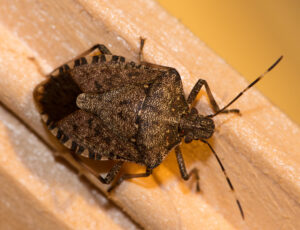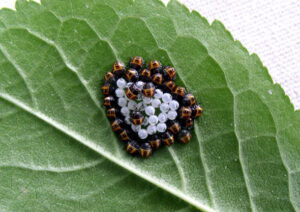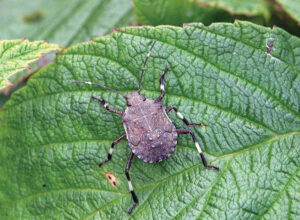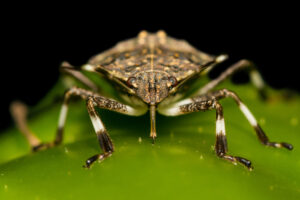Read the latest information on
Foot-and-mouth disease
The Brown marmorated stink bug (BMSB) (Halyomorpha halys) is an exotic pest known for its notorious ability to hitchhike its way to new locations. BMSB spreads through various pathways, including imported goods like machinery, vehicles and containerised goods, as well as travellers’ luggage.
BMSB poses a significant biosecurity threat, particularly between September and April, known as BMSB risk season. With the potential to affect over 300 different plants and crops, understanding and preventing its entry into Australia is crucial for protecting our agricultural industry.
An expert hitchhiker
When temperatures drop in winter, BMSB enters diapause (a period of suspended development in an insect) seeking shelter in cars, shipping containers, houses and even inside luggage and clothing. These hiding spaces help them to stay warm and, through human-mediated movement, enable them to spread to new locations like Australia where the climate is suitable for them to become active.
BMSB can also disperse naturally by flying. While their usual flight range is less than 5 km per day, they have been known to travel up to 75 km in a single day.
Native to Japan, Korea, China and Taiwan, BMSB is currently established throughout Asia and North America and has also spread to parts of Africa, South America and Europe.
The risk is significant in Australia, with both live and dead BMSB intercepted over the past decade from imported cars and containerised non-food goods, including machinery, general parts, and equipment. A recent incident involved a BMSB found in a traveller’s luggage from Japan in Sydney.
Despite increasing import requirements in Australia, including mandatory treatment during the risk period, the hitchhiking nature of BMSB continues to pose a serious threat.
What does it look like?
Adult BMSB measure between 12 to 17 mm in length and are mottled brown in colour, with white banding on their antenna and characteristic black and white banding around the abdomen.

Adult BMSB (Shutterstock)
The eggs of BMSB are smooth and pale, and approximately 1.6 mm long, typically laid in clusters of 20-30 on the underside of leaves.
Juvenile stages, or nymphs, range in size from 2.4 to 12 mm long. Young nymphs have an orange and red abdomen with black stripes around the edge and down the centre. Older nymphs tend to be darker with the banding pattern appearing on the legs and antennae.

BMSB eggs and young nymphs

Older BMSB nymph
Australia is home to native stink bugs that can look like BMSB. If you spot any brown stink bug that has the black and white banding on the abdomen, notice any insects resembling the described nymph stages, or see any insect in luggage from overseas or imported vehicles or machinery, report it to the Exotic Plant Pest Hotline on 1800 084 881.
What damage does it do?
BMSB feeds on a wide range of crops, including maize, soybean, sunflower, sorghum, pea, bean, cherry, apple, tomato, nuts, berries and many more. This pest causes significant crop losses by deforming pods and fruit and inflicting internal tissue damage. Its feeding method—piercing the surface of plants—can create entry points for pathogens like bacteria and fungi, further threatening crop health.

BMSB feeding (Shutterstock)
BMSB is also a nuisance pest. It emits a foul odour and tends to congregate in and around structures such as sheds and houses during winter. In the United States of America (US)., there have been reports of thousands of BMSB invading homes over winter.
What can I do?
If you are buying new or second-hand vehicles or farm machinery from overseas, thoroughly inspect them for any signs of insects. Similarly, if you have travelled overseas recently, ensure that all belongings and clothing are checked for signs of BMSB.
It’s important to be familiar with what is normal for your region and your crops. If you spot anything unusual or something that resembles BMSB, capture it in a container, take clear photos, and report it immediately to the Exotic Plant Pest Hotline on 1800 084 881, or contact your local state department of agriculture.
For more information, refer to the PHA BMSB factsheet or contact your local Grains Biosecurity Officer.
Launched in 2007, the Grains Farm Biosecurity Program is Australia’s flagship biosecurity extension program. The program is managed by Plant Health Australia (PHA) and funded by growers through Grain Producers Australia (GPA), with support from QLD, Victoria, Western Australia, New South Wales, and South Australia state governments.
Visit the Grains Farm Biosecurity website for helpful factsheets, videos, how-to guides, online courses and strategies to help you improve your biosecurity practices.